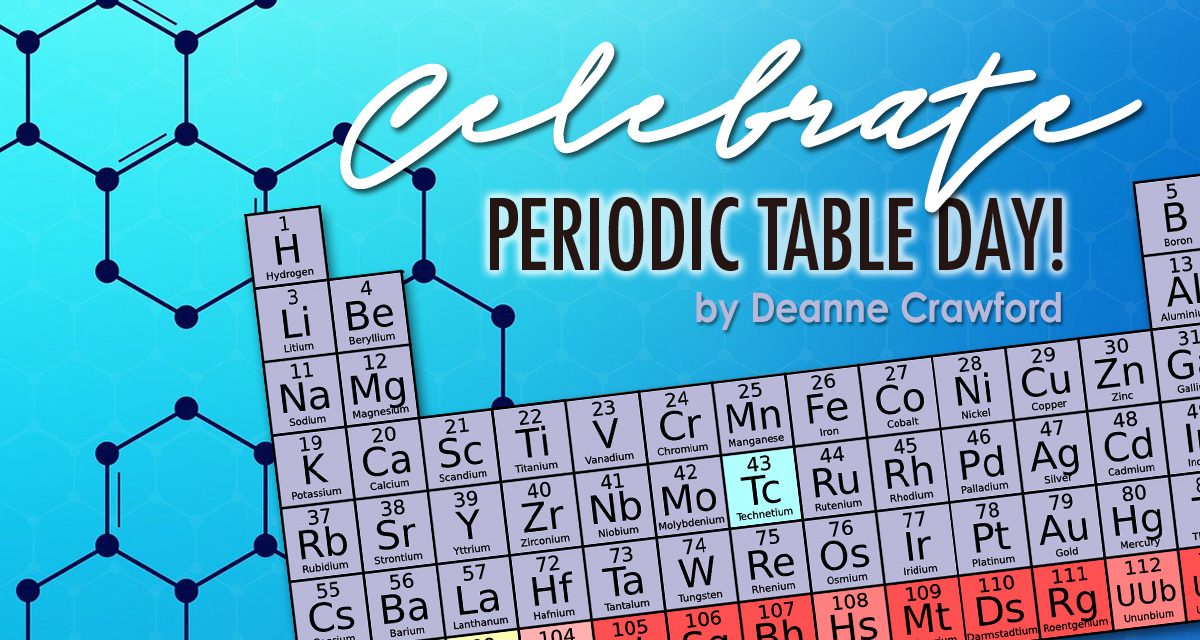Inspired by the dedication of scientists from over 150 years ago, Chemistry teacher Dr. David Steineker has created a day to celebrate one of science’s most recognizable icons: the Periodic Table of Elements. Most of us have seen the periodic table hanging on a school wall or designed on a coffee cup.
There is so much more to the periodic table than the bright colors and patterns. Did you know the Periodic Table of elements is one of the most significant achievements in science? This unique tool captures the essence of chemistry, as well as physics and biology. It also enables scientists to predict the properties of matter on the Earth and throughout the Universe. But does it have a story? And what is its purpose today? Whether you are a science friend or foe, I invite you and your children to join me this month in celebration of the remarkable periodic table!
It’s been said that the periodic table is as important to the understanding of Chemistry as understanding of DNA is to Biology. Take a quick peek at Duckster’s periodic table. Ask your children to share anything they know about the periodic table. Depending on their age and experiences, they may look at you with a blank expression. Simply defined, the periodic table is table or grid that displays all known chemical elements in order of their atomic number. To really understand the periodic table, we need to understand elements (or atoms) and their function in our world. Introduce elements and the periodic table to your children. Kid’s Learning Tube Periodic Table and Song (YouTube®) and Duckster’s™ Periodic Table provide a fun, understandable explanation for younger children. Older children may appreciate the clear teaching from Khan Academy. Spend time exploring the elements on the periodic table with the Interactive Periodic Table and the Ted Ed Periodic Table videos. Depending on your children’s interest, spend several days exploring these sites: lots of great information here! Just for fun, complete the interactive Elements word search or Crossword Puzzle.
At this point, your children may be saying, ‘Well that’s great Mom, but what does that have to do with me?” Other than a valuable resource used in your high school Chem classes (and quickly forgotten), is it useful? It is important to remember that the periodic table of elements was created to put all the known elements into groups, based on their unique properties. Understanding the periodic table and how the elements relate allows you to predict how similar elements will act. Let’s say your swimming pool has algae growing in it. You really want to clean it so you can go swimming! But your parents remind you that your little sister is allergic to chlorine, the most common chemical used in pools. Looking at the periodic table you see other chemicals listed by chlorine. Seeing this means that the properties are similar and you know that means they have similar properties. You decide to research to see if you can use one of these instead of chlorine. Above chlorine in the table is fluorine. Read this article about Fluorine. Would it work in place of Chlorine? (No; it is too reactive). Bromine is located below Chlorine. Would it work in place of Chlorine? Read about Bromine on Chem4Kids. Still unsure? Check out In the Swim’s Blog which compares using chlorine and bromine in pools.
Not only is it important to know the elements to keep your pool clean (and you safe!), understanding the elements is also vital to understanding our human body. Did you know that over 90% of your body is made up of elements? While our body contains 11 major elements from the periodic table, four of them make up 96% of our body weight. What are the main four? (oxygen, hydrogen, carbon, and nitrogen) Learn more about the elements and our body from ASU’s Ask a Biologist and YouTube®’s What are the Elements of the Human Body. We have spent some time learning about common elements; there are some very helpful elements that you don’t hear about as often. SciShow offers an excellent overview of 8 Lesser-Known Useful Elements on YouTube®. Wrap up your introduction to the Periodic Table by taking a scavenger hunt to identify common elements with this worksheet from the Homeschool Scientist.
The story behind the periodic table is fascinating. Russian Chemist, Dmitri Mendeleev, is credited for organizing the elements into a useful table format in 1869, but the story began a hundred years prior. As early as 1789, Antoine Lavoisier of France organized elements into four categories: metals, nonmetals, “earths” and gases, based on their physical and chemical characteristics. Fun fact: not only did he organize elements back in the late 1700s, but he also wrote the first Chemistry textbook, Elementary Treatise on Chemistry, based on his discoveries. Learn more about Antoine Lavoisier and modern Chemistry here. Other important scientists contributed to the periodic table’s development. Learn more about these early scientists at CK-12. However, it was Dmitri Mendeleev who first proposed a system that left space between known elements to add newly discovered elements to an organizational chart. Watch “The Genius of Mendeleev’s Periodic Table” on TED-ED to learn more about his brilliant idea that led to his becoming known as the father of the periodic table!
Thank you for joining me this month for a quick look at the periodic table of elements. Before wrapping up our Periodic table study, take time to listen to Tom Lehrer’s Elements song on YouTube®. This is a great tool to help teens memorize the elements of the periodic table!
If you have any topics you’d like us to cover in an introductory unit study, please feel free to email us! We would love to hear from you! ~ Deanne





